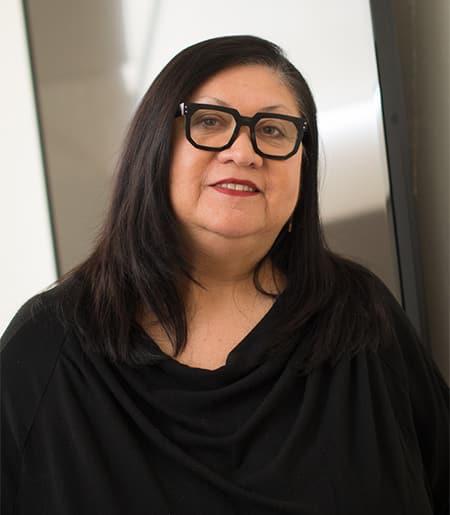Overview
Jolene Rickard is an Associate Professor at Cornell University in the departments of History of Art and Art, and the former Director of the American Indian and Indigenous Studies Program 2008-2020 (AIISP). She is a visual historian, artist and curator interested in the intersection of Indigenous art, cultural theory and the forces of settler colonialism. Her research centers on the expression of multiple sovereignties within Indigenous art and culture globally.
Jolene Rickard has been at the forefront of comparative understandings of global Indigenous art with research projects in the Americas, Australia, and Aotearoa (New Zealand). Her work bridges the fields of Native American and Indigenous Studies, Settler Colonial Studies and the discipline of Art History. Focused on the complication of sovereignty as a political, theoretical and activist action, Rickard investigates anti-colonial artistic strategies, place-based knowledges and ontologies.
Research Focus
Her practice is collaborative with an ongoing focus on the hemispheric entanglement of art, ecology, and migration in the Americas. Co-investigators and colleagues, Dr. Ananda Cohen-Aponte, Dr. Ella Diaz, and artist, Sandy Rodrigues continue with the ongoing project, “From Invasive Others Toward, Embracing, Each Other: Migration, Dispossession, and Place-Based Knowledge in the Arts of the Americas,” funded by Global Cornell and the Mellon Foundation’s Just Futures Initiative. She was a Fulbright Scholar at McMaster University, (CA), 2020.
Recent curatorial interventions include Deskaheh in Geneva, 1923-2023 : Defending Haudenosaunee Sovereignty (Geneva, Switzerland, 2023) where she considers the visibility of Indigenous governance within the context of the United Nations. Her current role as a consultant to the Niagara Falls State Park (NYS) interpretive museum and the Royal Ontario Museum (CA) contributes to updating Indigenous perspectives in public spaces. She also co-curated two of the four inaugural exhibitions of the Smithsonian’s National Museum of the American Indian (2004-2014).
Jolene’s current book project, Gayogo̱hó꞉nǫ' Stone Carving and Shaping Time, sets in dialogue the work of master soapstone (steatite) carver Joseph Jacobs (Gayogo̱hó꞉nǫ' / Cayuga Nation) with Haudenosaunee cosmological perspectives as an illustration of relationships to more than human beings. This research seeks to recognize an Indigenous temporal relationship to time and place requiring a significant shift in what modernity means from a Western philosophic perspective.
Highlights of Jolene’s recent art exhibitions include Speaking with Light: Contemporary Indigenous Photography, Amon Carter Museum of American Art (2022), Minneapolis Institute of Arts national exhibition, Hearts of Our People: Native Women Artists, (2019-2021), and Crystal Bridges Museum of Art, Art for a New Understanding: Native Voices, 1950’s to Now (2018-2020).
Jolene has been instrumental in supporting the infrastructure to raise the visibility of Indigenous Art. She is on the editorial board of American Art, a founding boardmember for the Otsego Institute for Native American Art and an advisor to GRASAC - The Great Lakes Alliance for the Study of Aboriginal Arts and Culture and is part of the Inaugural Forge Project’s Indigenous Steering Council.
She is from the Skarù·ręʔ / Tuscarora Nation, Hodinöhsö:ni Confederacy.
Awards and Honors
New Frontier Grant (2024)
Publications
A selection of publications includes: “Art, Visual Sovereignty, and Pushing Perceptions,” in The Routledge Companion to Indigenous Art Histories in the United States and Canada (2022). Her 1984 essay, “Sovereignty: A Line in the Sand” is included in Native Visual Sovereignty: A Reader on Art and Performance, The Forge Project, D.A.P. (2023). Other publications include, Diversifying Sovereignty and the Reception of Indigenous Art, Art Journal 76, no. 2 (2017), Aesthetics, Violence and Indigeneity, Public 27, no. 54 (Winter 2016), Arts of Dispossession, in From Tierra del Fuego to the Arctic: Landscape Painting in the Americas, Art Gallery of Ontario (2015), The Emergence of Global Indigenous Art, Sakahán, National Gallery of Canada (2013), and Visualizing Sovereignty in the Time of Biometric Sensors, The South Atlantic Quarterly: Sovereignty, Indigeneity, and the Law, 110:2 (2011).
In the news
- ‘Defending Haudenosaunee Sovereignty’ exhibit opens Sept. 24
- Mohawk community newspaper founder to give Kops Lecture
- Projects funded by 2024 New Frontier Grants look toward the future
- Community read launches Society for the Humanities’ ‘Repair’ theme
- Collaboration plants seeds for cultural, biological conservation
- Grants fund community-engaged learning curricula
- Faculty research university’s ties to Indigenous dispossession
- New Cayuga language class focuses on nature, culture
- Grad students honor three A&S professors with awards
- Language Resource Center podcast highlights indigenous languages
- New provost's task force continues push for a diverse Cornell faculty
- New proposals sought for digital grants
